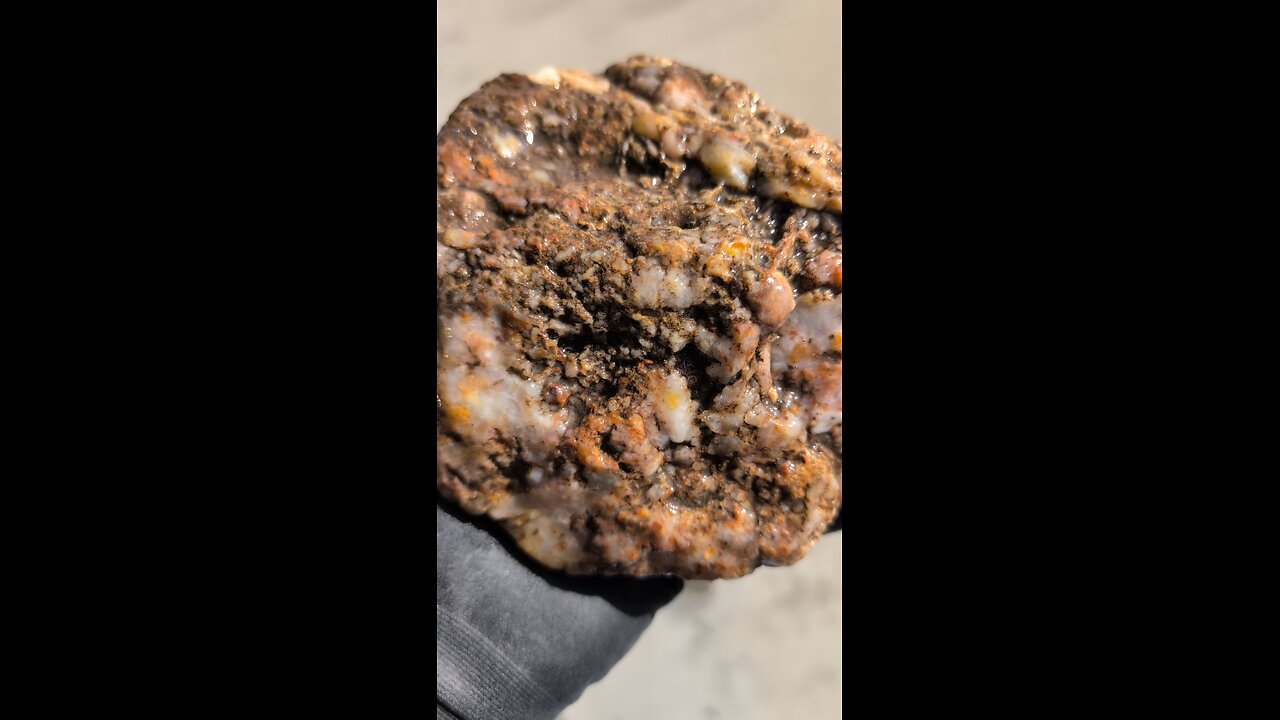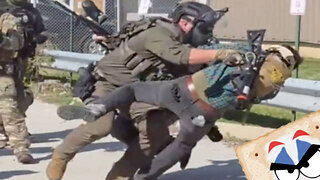Premium Only Content

Hot mess!
This rock has a rough, irregular texture with a mix of brown, reddish-orange, and white colors, along with a glossy, possibly wet or polished appearance. It also shows crystalline or granular patches, particularly the white areas, which could indicate mineralization. Here’s my analysis of what this rock might be, considering the context of Lucky Peak Reservoir near Boise, Idaho:
Quartz or Quartz Vein Material: The white, crystalline patches suggest the presence of quartz, which often forms in veins or pockets within other rocks. The reddish-brown and orange colors could be iron oxide (hematite or limonite) staining or inclusions, common in quartz deposits. This rock might be a piece of a quartz vein or a quartz-rich breccia (a rock made of broken fragments cemented together). Quartz is abundant in Idaho, including in the volcanic and metamorphic rocks of the Idaho Batholith, which extends into the Boise area.
Jasper or Chert with Quartz Inclusions: The earthy colors (brown, red, orange) and glossy surface could indicate jasper or chert, both of which are microcrystalline quartz varieties. The white patches might be larger quartz crystals or calcite infill within the jasper or chert matrix. Jasper and chert are found in sedimentary and volcanic settings, which are present near Lucky Peak. The rough texture and coloration align with these materials, though the crystalline patches make quartz a significant component.
Breccia or Conglomerate: The rock’s appearance, with its mix of colors and textures, could indicate a breccia (angular fragments cemented together) or conglomerate (rounded fragments). The white areas might be quartz or calcite cement, while the brown and red hues could be from iron oxides or other minerals. This type of rock could form in the dynamic geological environment of the Boise region, where volcanic activity, sedimentation, and tectonic forces have created complex rock formations.
Petrified Wood or Silicified Material: While less likely, this could still be a highly altered form of petrified wood or silicified material, where the original wood has been replaced by quartz or other minerals, leaving behind a mix of colors and textures. The crystalline white patches could be quartz infill, and the brown/red colors might be iron oxides. However, the lack of clear wood grain patterns makes this less probable than quartz or jasper.
The geology around Lucky Peak Reservoir includes volcanic rocks (like rhyolite and basalt), sedimentary deposits from the Boise River, and metamorphic rocks from the Idaho Batholith. The Boise River and its tributaries could carry such rocks downstream, and natural weathering or tumbling could explain the polished or glossy look. The presence of quartz, along with iron oxides, suggests a mineralized deposit, possibly from a vein or fracture zone in the local bedrock.
To narrow it down further, consider:
The rock’s hardness (quartz, jasper, and chert are around 6.5-7 on the Mohs scale—scratch it with a knife or steel to test).
Where it was found—near Lucky Peak or the Boise River would support quartz, jasper, or chert, all of which occur in Idaho.
Its weight and density—quartz and related materials feel heavy for their size due to their silica content.
Whether the white areas are truly crystalline (quartz) or more chalky (calcite, which would fizz with acid like vinegar).
Given the context and appearance, I’d lean toward quartz-rich material, possibly a quartz vein or breccia with iron oxide staining, or jasper/chert with quartz inclusions. Both are plausible for the Boise area’s geology.
-
 10:34
10:34
The Pascal Show
17 hours ago $6.40 earnedFOOTAGE REVEALED! Images Of Celeste Rivas Exposed Before Her Disappearance From Home Running To D4vd
30.6K3 -
 LIVE
LIVE
Lofi Girl
2 years agoSynthwave Radio 🌌 - beats to chill/game to
327 watching -
 4:23:47
4:23:47
MissesMaam
12 hours ago*Spicy* Friend Friday with Mally_Mouse and Friends!! 💚✨
317K19 -
 2:05:09
2:05:09
TimcastIRL
13 hours agoRIOTS Leftist ATTACK ICE, Tear Gas Deployed, Feds Ordered To IGNORE CA Law, CIVIL WAR! | Timcast IRL
356K321 -
 15:57
15:57
Robbi On The Record
1 day ago $9.57 earnedTranshumanism: Are Humans Becoming Obsolete? Neuralink & CRISPR explained
62.8K24 -
 2:22:21
2:22:21
TheSaltyCracker
13 hours agoICE Smashing Antifa ReeEEStream 9-26-25
143K224 -
 7:47:28
7:47:28
SpartakusLIVE
14 hours ago#1 HERO of the PEOPLE || Ending the Week with FUN, WINS, and LAUGHS
95.4K -
 3:52:22
3:52:22
SynthTrax & DJ Cheezus Livestreams
1 day agoFriday Night Synthwave 80s 90s Electronica and more DJ MIX Livestream THE FLOATING WORLD / Variety Music Edition
48K4 -
 7:43:24
7:43:24
Eternal_Spartan
20 hours ago🟢 Eternal Spartan Plays Destiny 2 | FPS Friday | | USMC Veteran
54.7K4 -
 2:04:11
2:04:11
MattMorseTV
14 hours ago $26.58 earned🔴The UK just hit ROCK BOTTOM.🔴
82.8K202